The recent developments in Dylan’s behaviour are so puzzling they seem to need left field answers. I pore over the incident log searching for a pattern. When I can’t find one I turn it around and look again; it must be here somewhere, I tell myself, I just can’t see it. I share the log with others – maybe they will see something I’m missing.
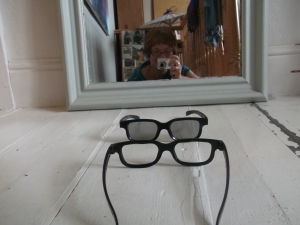 Living with autism is a bit like being a detective. Usually I enjoy this; stumbling across the unexpected or finding a missing piece of puzzle is satisfying. Perhaps this time I’m looking too hard or in the wrong places: if there isn’t an obvious explanation I’m probably not going to find a cryptic solution in a log. Maybe I just need to stay watchful so I don’t miss the clues when they come.
Living with autism is a bit like being a detective. Usually I enjoy this; stumbling across the unexpected or finding a missing piece of puzzle is satisfying. Perhaps this time I’m looking too hard or in the wrong places: if there isn’t an obvious explanation I’m probably not going to find a cryptic solution in a log. Maybe I just need to stay watchful so I don’t miss the clues when they come.
My records, for example, could be part of the problem. Perhaps I can’t find a pattern not because of the way I’m looking at the log but because of the way I’m seeing the behaviour. Parenting Dylan, I’ve suggested before, is like ethnography; to understand his world I’ve had to walk in his shoes and look with his eyes. If I can’t make sense of Dylan’s behaviour then maybe I need a different way of seeing – otherwise, I might not stand a chance of that flash of light from the left hand side.
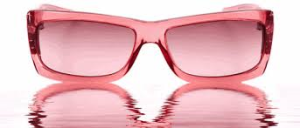 My friend Jack, who blogs about being the sibling of an autistic man (among other things), can turn a cliché on its head. We view the past, he says, through sepia spectacles; it is the future we see through rose-coloured glass. Such optimism. Parents of autistic children can feel deep anxiety about the future but I suspect many of us bury it. I don’t know whether I have become a more positive person through Dylan’s autism or whether I was always an optimist but these days I wear prescription rose. They’re good up close, I think, but not so great at a distance. Perhaps that’s part of the problem: could my present-time focus be preventing a long-view of Dylan’s needs?
My friend Jack, who blogs about being the sibling of an autistic man (among other things), can turn a cliché on its head. We view the past, he says, through sepia spectacles; it is the future we see through rose-coloured glass. Such optimism. Parents of autistic children can feel deep anxiety about the future but I suspect many of us bury it. I don’t know whether I have become a more positive person through Dylan’s autism or whether I was always an optimist but these days I wear prescription rose. They’re good up close, I think, but not so great at a distance. Perhaps that’s part of the problem: could my present-time focus be preventing a long-view of Dylan’s needs?
*
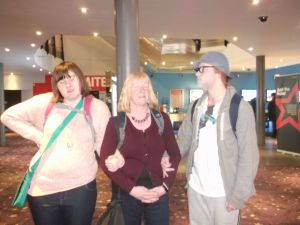 Here’s Dylan with our friends Julie and Ella earlier this year; we’d been to Cineworld to see Tarzan. Ella is a seasoned cinema-goer but for Dylan this is still a relatively-new experience. I have worked hard over the last few years to support Dylan to access the cinema; we started with Autism-Friendly screenings and after a while were able to attend selected mainstream films. On this occasion Julie and I had planned to take Ella and Dylan to the cinema at the end of a canal walk; we would be tired and this would be a good way to end the day.
Here’s Dylan with our friends Julie and Ella earlier this year; we’d been to Cineworld to see Tarzan. Ella is a seasoned cinema-goer but for Dylan this is still a relatively-new experience. I have worked hard over the last few years to support Dylan to access the cinema; we started with Autism-Friendly screenings and after a while were able to attend selected mainstream films. On this occasion Julie and I had planned to take Ella and Dylan to the cinema at the end of a canal walk; we would be tired and this would be a good way to end the day.
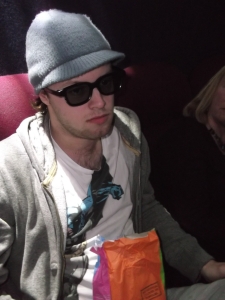 As it was hard to judge timings we would have to choose the film on arrival; not a problem at a cinema complex where there would be multiple screenings of children’s films. The first suitable film, however, turned out to be a 3D screening. Dylan hadn’t been to a 3D film before. I don’t think he’ll wear the glasses I said to Julie. As the glasses came in sealed bags we couldn’t try them before buying tickets. If Dylan wouldn’t wear the glasses, the man at the desk advised, he wouldn’t be able to enjoy the film; without them it would look blurry. The next regular screening was not for another hour; Dylan wouldn’t wait that long so, armed with pick ‘n’ mix and specs, we went in.
As it was hard to judge timings we would have to choose the film on arrival; not a problem at a cinema complex where there would be multiple screenings of children’s films. The first suitable film, however, turned out to be a 3D screening. Dylan hadn’t been to a 3D film before. I don’t think he’ll wear the glasses I said to Julie. As the glasses came in sealed bags we couldn’t try them before buying tickets. If Dylan wouldn’t wear the glasses, the man at the desk advised, he wouldn’t be able to enjoy the film; without them it would look blurry. The next regular screening was not for another hour; Dylan wouldn’t wait that long so, armed with pick ‘n’ mix and specs, we went in.
 All appeared to be going well. I explained to Dylan about the glasses. I photographed him in them. He seemed pretty chilled. I turned to Julie; when I looked back Dylan had removed the lenses from his specs. Julie and I tried every which way but could not get those lens back into the frames. It was frustrating for me to have paid for glasses that hadn’t lasted to the start of the film but it would be even more frustrating for Dylan once the film started…
All appeared to be going well. I explained to Dylan about the glasses. I photographed him in them. He seemed pretty chilled. I turned to Julie; when I looked back Dylan had removed the lenses from his specs. Julie and I tried every which way but could not get those lens back into the frames. It was frustrating for me to have paid for glasses that hadn’t lasted to the start of the film but it would be even more frustrating for Dylan once the film started…
In the event we managed; Julie and I shared, sacrificing Tarzan’s outlines so that Dylan could experience him in 3D. Dylan seemed to prefer his lens-free glasses: he wore them as we left the cinema and, as I remember, kept them on in the restaurant afterwards. I think he looks rather handsome; the frames suit him. Julie pointed out it was actually a sensible thing for Dylan to have done: You gave him some glasses he couldn’t see through. He wanted to see so he took the lenses out.
*
 I have two pairs of glasses (as well as my rose spectacles) which I alternate between. My optician tells me that bifocals are inevitable at some point. This has happened recently and fairly rapidly; I’ve not had to think about my own eyesight much before now. I did, however, have to spend time at the eye hospital when my daughter was young.
I have two pairs of glasses (as well as my rose spectacles) which I alternate between. My optician tells me that bifocals are inevitable at some point. This has happened recently and fairly rapidly; I’ve not had to think about my own eyesight much before now. I did, however, have to spend time at the eye hospital when my daughter was young.
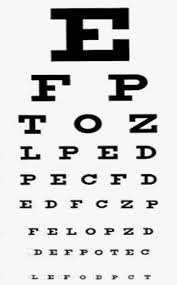 She had a squint or ‘lazy eye’; her father noticed it when she was only three years old (for some reason I could never see it) so it was picked up relatively early. Before a treatment path could be decided upon the doctors needed to undertake a comprehensive assessment of my daughter’s eyes including standard sight testing. This wouldn’t be possible, I told the optometrist. Her eyebrow raised. I could see ‘problem mother’ written across her face. Well we’ll just have a go shall we, she said. But my daughter, I explained, wouldn’t be able to complete the test because she didn’t know the alphabet: she won’t be able to tell you what she can see, I said.
She had a squint or ‘lazy eye’; her father noticed it when she was only three years old (for some reason I could never see it) so it was picked up relatively early. Before a treatment path could be decided upon the doctors needed to undertake a comprehensive assessment of my daughter’s eyes including standard sight testing. This wouldn’t be possible, I told the optometrist. Her eyebrow raised. I could see ‘problem mother’ written across her face. Well we’ll just have a go shall we, she said. But my daughter, I explained, wouldn’t be able to complete the test because she didn’t know the alphabet: she won’t be able to tell you what she can see, I said.
My daughter was at a Steiner kindergarten and in line with Steiner philosophy my husband and I had made a decision not to introduce formal learning until she was seven. My daughter would not therefore be able to name the letters on the sight chart even if she could see them. The assessments were re-scheduled and in due course full measures obtained. I sometimes wondered whether the delay in gathering this data altered the course of treatment; although there had been talk of surgery my daughter controlled the squint and there was no intervention.
Dylan’s sight and hearing have never been assessed and, given the way measurements are taken, it is unlikely that they could be; for all I know Dylan may be short- or long-sighted. Medical tests and examinations require more than the informed consent of the patient (challenging as that can be); they usually require language and sometimes literacy. My daughter’s inability to report what she could see because she wasn’t yet literate was temporary; not completing the eye test did not have major implications for her health (and may even have helped given that it delayed intervention). For someone like Dylan, however, who is neither literate or verbal, the challenge posed by the need for medical examination is significant.
*
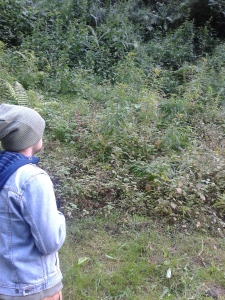 Dylan has now been referred for neurological and psychological assessment; while the changes in his behaviour may be functional and an attempt to communicate, there is a possibility that Dylan is having seizures. Before Dylan is able to access specialist services, however, he needs to have had a full medical examination to rule out other possible causes. Dylan may, for example, have a persistent ear infection or chronic disturbance in his ear; this could explain why Dylan grabs at ears during an episode. Equally, Dylan may be experiencing headaches or some other underlying problem; the nose bleeds which Dylan has always been prone to have increased in frequency and duration in recent weeks.
Dylan has now been referred for neurological and psychological assessment; while the changes in his behaviour may be functional and an attempt to communicate, there is a possibility that Dylan is having seizures. Before Dylan is able to access specialist services, however, he needs to have had a full medical examination to rule out other possible causes. Dylan may, for example, have a persistent ear infection or chronic disturbance in his ear; this could explain why Dylan grabs at ears during an episode. Equally, Dylan may be experiencing headaches or some other underlying problem; the nose bleeds which Dylan has always been prone to have increased in frequency and duration in recent weeks.
Getting Dylan to accept a medical examination is, however, another matter; he refuses to allow our family doctor to carry out even the most perfunctory of observations. I have made previous reference to Dylan’s refusal to consent to medical intervention here and here. Apart from a couple of emergency situations this has never posed a problem in that Dylan has always been healthy.
Recent developments have, however, put Dylan in a difficult position in relation to medical services. The possibility that his distress may be due to an undiagnosed medical condition is troubling; Dylan does not understand that ‘medicine’ is a good thing and can make you better and he cannot therefore make an informed decision to accept or reject it. I act in his best interests. At what point might that involve over-ruling Dylan’s resistance? And what exactly might that involve?
In a previous post I have argued that we cannot leave autistic children until they are adults to encounter medical services. By then they may, like Dylan, be resistant to something which is unfamiliar and feels threatening. While Dylan was growing up I helped him to establish boundaries in relation to his own body; how does he square medical examination with my insistence that he shouldn’t remove clothing in front of strangers or let anyone touch him? I realise, now, that this lesson needs qualification.
*
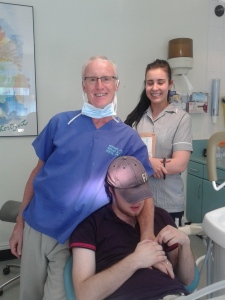 I once read that the development which has contributed most to human happiness is dental care; before advances in dentistry, apparently, toothache was responsible for great misery. Happily Dylan (as far as I know) does not suffer from toothache; Mr Jones the dentist has worked patiently to support Dylan through ‘rides on the chair’ to the full examinations he now receives regularly. I have no idea whether this would help if Dylan ever needed any work doing but it would, presumably, assist with diagnosis.
I once read that the development which has contributed most to human happiness is dental care; before advances in dentistry, apparently, toothache was responsible for great misery. Happily Dylan (as far as I know) does not suffer from toothache; Mr Jones the dentist has worked patiently to support Dylan through ‘rides on the chair’ to the full examinations he now receives regularly. I have no idea whether this would help if Dylan ever needed any work doing but it would, presumably, assist with diagnosis.
Surely we could apply the model of regular dental check-ups to general health care for autistic children? Regular contact with professionals and equipment (stethoscopes, thermometers, BP monitors etc) when Dylan was young could have helped prepare him to accept the basic medical observations he is so in need of now. If you are a parent of a young autistic child, you might want to lobby your education provider to incorporate such a programme. Alternatively, you could take your well child for regular check-ups with your family doctor; one day you may be glad you did 🙂
*
All images taken by Liz except for the rose-coloured spectacles (huffingtonpost.co.uk) and the sight test chart (verywellbeing.co.uk).
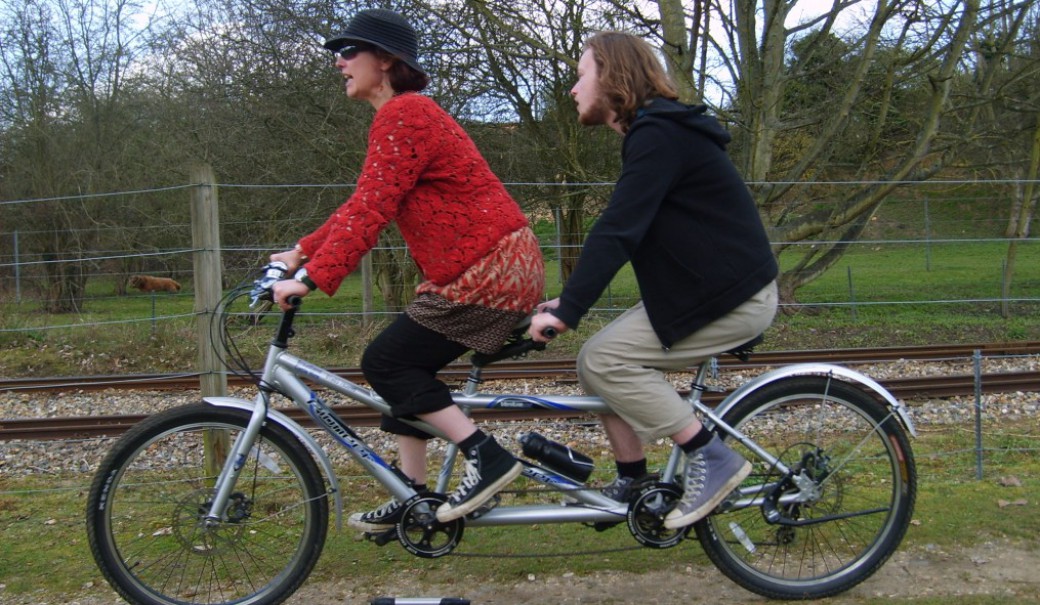

Pingback: Getting Bloggy: an update and an elephant | Living with Autism
Pingback: Peeing In A Pot: a quiet celebration | Living with Autism
Pingback: A Tough Nut To Crack: reflections on control | Living with Autism
Pingback: In Praise Of Groups | Living with Autism
Pingback: Autism And Friendship: learning from Dylan | Living with Autism
Pingback: Dylan And The Dinosaur Of Anxiety | Living with Autism
Pingback: The Last Lap And The Car Wash | Living with Autism
Pingback: And Finally | Living with Autism